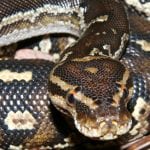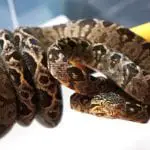Scientific Facts
| Common Name | African Fat-Tailed Gecko |
| Scientific Name | Hermitheconyx caudicinctus |
| Life Span | In captivity, between 10 to 25 years, in the wild, unknown. |
| Size | 7 to 9 inches long from head to tail 40 to 90 grams of weight |
| Habitat | Dry and arid regions |
| Country of Origin | Only in West Africa from Senegal to Cameroon |
Physical Description
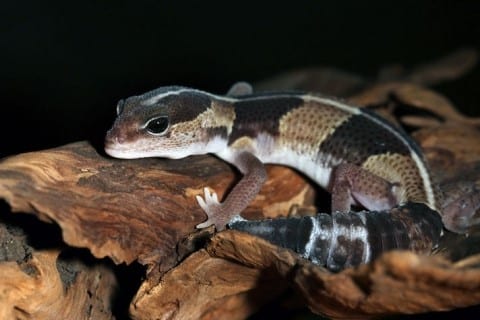
The African Fat-Tailed Gecko is a lizard that’s common in the western parts of Africa. It is a nocturnal animal that lives underground in the desert areas of the continent. This should not be confused with the common leopard gecko because these lizards may look similar but have different color markings, tail size, and overall size.
This gecko may not be readily available in most pet shops locally, but it is popular online. It has charmed lizard lovers because of its lovely appearance, docile nature, and their ability to thrive very well in captivity.
The African Fat-Tailed Gecko is sexually dimorphic, with male lizards larger and more stunning than their female counterparts. This lizard is a medium-sized gecko with an average weight. The female is larger in this species and may look very delicate.
Their skin has impressive color combinations ranging from beige to tan with brown stripes with a slightly pink to the off-white underbelly. There is a distinct thin white line from the head to the tail of this gecko, and this is what makes it different from other pet lizards.
The African Fat-Tailed Gecko has small cute black eyes that can be round, triangular, or almond-shaped. Many pet owners say that this is the most charming feature of this little gecko. Finally, it has a distinct wide and thick tail, which is why it has earned its name “fat-tailed” gecko. The tail has vertical segments that gradually becomes thinner up to the tip of the tail.
Types

The African Fat-Tailed Gecko belongs to the sub-family Eublepharinae. Popular members of this family include the leopard gecko from South Central Asia, Pakistan, and India. Compared to other subfamilies, the Eublepharinae have different features than other geckos. These lizards are terrestrial and are nocturnal. Also, this subfamily has moveable eyelids, no sticky feet or adhesive lamellae, and has vertical pupils. And just like most gecko species, the African Fat-Tailed Gecko may lose its tail when it feels threatened or in stress. If it loses its tail, a new one can grow in its place. More on this unique characteristic of this gecko later.
Life Span
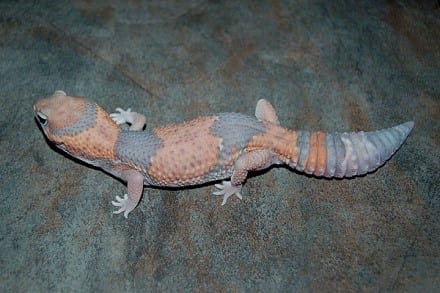
The African Fat-Tailed Gecko can live for 10 to 25 years in captivity with an average of 15 years. There is no information as to how long this gecko can live in the wild. According to the IUCN Red List, this gecko species is of Least Concern. This is because it is widespread and common in its natural habitat. This lizard may only be affected by localized threats.
The African Fat-Tailed Gecko has three life stages similar to most lizard species:
1) Hatchlings
After a quick gestation period, baby hatchlings will come out of their eggs. Each hatchling weighs only 4 grams and is already able to walk and look for food.
2) Juvenile
During the juvenile stage, both male and female African Fat-Tailed Geckos will grow equally. The male and female will have the same weight and size. But the males may have a more colorful appearance.
3) Adult
Adult African Fat-Tailed Geckos reach maturity between 8 to 11 months. The males start to grow larger and heavier than females. Mating between male and female geckos is polyandrous, which means the male and the female may have partners in a breeding season.
Eating Habits
The fat-tailed gecko eats a lot of insects in the wild. In captivity, these lizards will eat live food like mealworms and crickets. You may also feed this gecko waxworms, silkworms, and pinkie mice. However, these must only be given as a supplement because these have high-fat content.
Babies or geckos that are younger than 4 months should be given live crickets daily. Juvenile and adult geckos should be fed at least nine crickets or mealworms a week.
Pick the cricket; you will feed your lizard. It must be the correct size so your pet can eat it right away. Expert lizard recommends ½ sized crickets that are hatchlings six weeks old and 2/3 sized crickets for a juvenile to adult. You can place crickets inside the cage or enclosure, allowed to move around the area. But if the lizard does not eat the cricket after a few hours, remove it. You can leave mealworms in a shallow dish inside the enclosure.
You must gut load the insects you feed with commercial gut load mix, or you may use baby cereal, dog, or cat food or fish flakes. Other pet owners gut load their insects with romaine lettuce, dandelions, or leafy greens. In case you have never heard of gut loading, this is a method of using prey insects as a way to pass nutrients to your pet. Use calcium powder to dust food before giving it to your pet.
And since this gecko is nocturnal, feed it in the evenings when it is most active. Don’t leave its prey roaming inside the tank in the morning. Just load it in when the gecko is awake.
Water
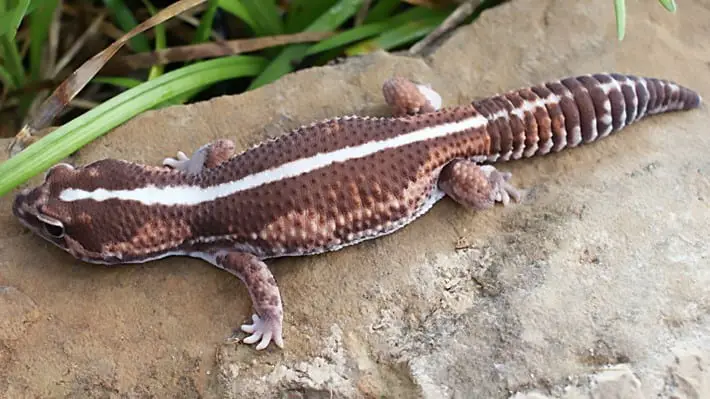
African Fat-Tailed Geckos need fresh water. Place a dish of clean water inside its enclosure. Change this water daily and make sure to clean the dish regularly too to prevent bacterial contamination of the enclosure.
Water in a large shallow dish for swimming is not needed by land-dwelling lizards like the African Fat-Tailed Gecko. It would prefer to remain under the lamp to bask rather than to swim in the water.
Development and Reproduction
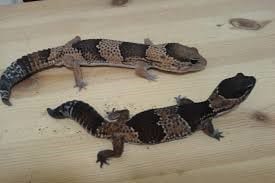
In fat-tailed geckos, the competition during reproduction exists only in males and is not a pressure among female geckos. As mentioned, the mating system is complicated since males and females may have multiple partners in a breeding season in a year.
The breeding season lasts for only five months a year, and at this time, both adult males are very busy mating and looking for mates.
Female African Fat-Tailed Geckos may lay up to five clutches in a year, but some females may lay fewer eggs. The gestation period is short, and when it’s over, baby geckos will tear the eggs apart and come out. Each baby gecko weighs around 4 grams but will soon double their size and weight in a matter of a few weeks.
How to Breed
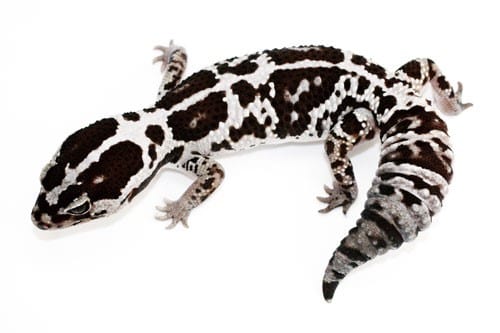
When it comes to breeding African Fat-Tailed Geckos, you need a healthy, adult, or sexually-mature geckos. According to expert gecko breeders, they start when the males are 7 months old and should weigh around 40 grams. Some breeders select a breeding male, but this is not always the oldest and the heaviest but most likely the healthiest. Meanwhile, females should be at least 8 months of age and must weigh 45 grams. Captive breeding of African Fat-Tailed Geckos has led to different colors, designs, and traits of fat-tailed geckos.
Breeding time for captive geckos happens from November to March. As much as possible, follow the natural breeding cycle of these animals in the wild. What breeders have experienced, breeding in late fall, in winter and in springtime has the best success.
Start by cooling the enclosure
Breeders recommend stimulating the natural timing of breeding, which is during the coolest time of the year. This short cooling down period can stimulate breeding in geckos, especially when you live in a warm or dry area. However, this may not be necessary if you are located in an area where there are four distinct seasons.
To provide a cool environment, start the middle of the year through fall. Normal temperatures are 88 to 92 degrees Fahrenheit in a hotspot while the cooler side of your enclosure should be around 75 to 80 degrees Fahrenheit.
Reduce the enclosure temperature by two degrees daily until geckos have 82 degrees in the hotspot. At the cooler part of the cage should be at around 70 degrees. You may turn off the heat inside the cage at night to lower temperatures in the mid-1970s.
Place the fat-tails on dry bedding or substrate like paper towels or newspapers as your geckos stay in a cooling period. Always maintain a clean bowl of water inside the tank at all times. Once you cool down the tank, don’t feed them. Lowering tank temperatures can slow down the metabolism of the lizards; therefore, these won’t burn too much weight at this period. Cool the tank down for about 4 to 6 weeks. This will be enough to stimulate breeding in both males and females.
And after this long cooling phase, you can start increasing the temperature inside the tank daily until you are back to the normal tank temperature. During the warm period, resume feeding, but during the first few days, reduce the number of live feedings. And instead of using newspapers or paper towels, increase the substrate to improve humidity inside the tank.
Introducing males to females
Once the tank is back to its regular temperature and you are giving your lizards their usual amount of food, you may now introduce males and females. You can use multiple tanks to group the geckos for breeding success.
A breeder claims he has a higher success rate by leaving one male to two or three females in one tank. Usually, breeding happens shortly after the introduction, and females will quickly ovulate with eggs developing shortly afterward.
After the introduction, place an egg box inside the tank but not directly under the lamp or in the hotspot to prevent drying of the eggs. An egg box with a hole that’s s1.5-inches on top is right for females. This way, she can move in and out of the egg box as she pleases. Fill the area surrounding the egg box with damp soil. Place a small amount of damp soil inside the egg box, as well.
Always keep a close eye on the females because sometimes these will lay their eggs outside the egg box. Usually, females lay eggs two at a time while some may lay only one egg.
During egg-laying season, females must be fed heavily. You should offer her food, as much as she can take. Gut feed the insects you give your female and add supplements as well. This will ensure that the female remains healthy and her eggs healthy as well.
Care for eggs that have hatched
As soon as you see eggs deposited inside the egg box, remove these and place these inside an egg incubation cup. Use an 8-ounce cup to incubate the eggs. Fill these with the same soil mix inside the tank. Wet the soil until this is damp. This is the best environment to incubate African Fat-Tailed Gecko eggs.
Take note that incubation temperatures will affect the gender of the hatchlings. An all-female or predominant female clutch is incubated 83 to 85 degrees. For more males or predominant male hatchlings, an incubation temperature of 88 to 89 degrees is best. However, a higher enclosure temperature can make the breeding geckos more aggressive. A thing called “fatal incubation” happens when temperatures are lower than 82 and higher than 93.
Incubation time is from 55 to 70 days for eggs incubated at 83 to 85 degrees. Eggs that are incubated at 88 to 89 degrees will hatch from 43 to 48 days. As soon as hatchlings come out of the eggs, place these in a tank lined with paper towels. The temperature requirements for the tank is similar to the tanks with adult African Fat-Tailed Geckos. Give food to newly-hatched geckos after a few days. And as soon as these weigh around 15 grams, you may now place these in juvenile tanks or housing.
Common Health Problems
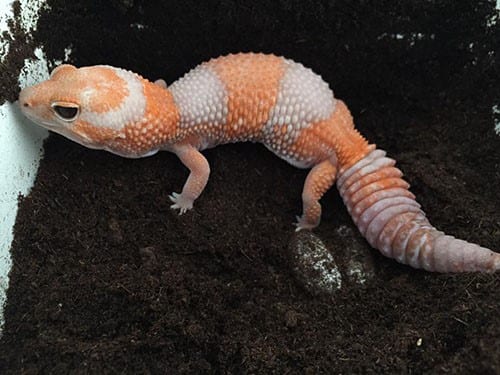
Here are the five common problems that African Fat-Tailed Geckos experience:
1) Poor shedding
The ability to shed completely and easily is one way to gauge good health in geckos. Healthy lizards that live in an enclosure with a good environment will shed regularly. This is to the point that the pet owner may not even notice that shedding has happened!
Take note of signs of shedding difficulties like skin shedding in pieces instead of one piece, skin clinging on the tail or the eyes, and signs of restlessness.
Any stuck skin should be removed right away because this can cling on the extremity and can cause constriction and damage. If you can handle your gecko, soak it in warm water for a few minutes. You may also use a gecko sauna box using a plastic container and warm water. Just place the lizard in and let the water soften the dead skin.
But for any severe shedding condition, consult a vet at once. A vet can help remove shedding and will also treat wounds or cuts due to incomplete shedding.
2) Metabolic Bone Disease
Geckos need calcium for strong bones and vitamin D3 to metabolize calcium. Calcium supplements are available in which you can feed your lizards while vitamin D3 is provided by using UVB lamps in your tank.
MBD is the lack of calcium in bones, and symptoms are deformities in the lizard’s skeletal system. This occurs over time but may also show acute symptoms like bowed legs, a rubbery jaw that affects the way they eat their food and kinks in the spine, which can be seen upon closer inspection.
Some hatchlings are born with the inability to manufacture calcium, leading to MBD. Also, females that hatch their eggs require more calcium. MBD is reversible by increasing vitamin D3 and calcium intake. You can directly apply calcium supplement by just dipping your finger in the calcium powder and applying this on your gecko’s mouth. You must also invest in a reliable UVB lamp for daily vitamin D3 intake.
3) Parasites
Geckos come with a low level of parasites, which don’t affect their health. But if the gecko becomes stressed or suffer from any immune system condition, the parasites can multiply, and this can affect his health. Also, these microorganisms can multiply and affect other animals and even humans.
To avoid the spread of parasites and infections, quarantine a new lizard. Always check for signs of parasitic infections like smelly or runny poop, weight loss, a bloated abdomen, anorexia, and lethargy or lack of energy.
If you notice any of these symptoms, take your pet to the vet. Clean and disinfect your gecko’s enclosure to prevent reinfection.
4) Wounds
Sometimes geckos like the African Fat-Tailed Gecko can have confrontations with other geckos found in the same tank. And any fights usually don’t end well with geckos since these lizards may bite each other and scratch their skin.
Any kind of wound must be treated right away. Small cuts and wounds should be washed with clean water and disinfected with Betadine or any disinfectant. For deeper and worse cuts, take your gecko to the vet for proper treatment.
5) Stress
Geckos are prone to stress. It may be due to many reasons like a new environment, a new cage mate, overcrowding, poor husbandry, and breeding. Stressed geckos don’t heat, may have depressed immune systems, and may have problems shedding. The best way to treat stressed geckos is to remove the stressor, give it time to adjust to his new environment, and just leave it alone. Sometimes, too much handling can also stress a gecko.
Preventing Illness
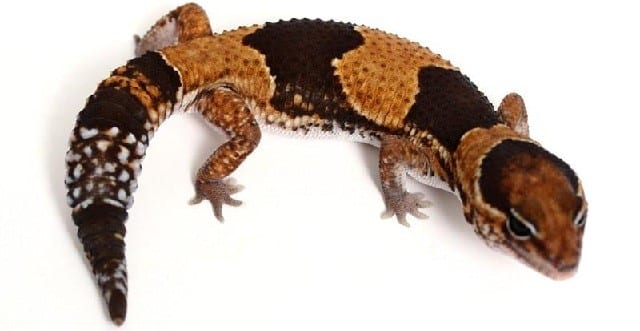
To prevent illness and other health conditions, keep the tank temperature and humidity at the best levels. This is the most common reason why pet geckos like the African Fat-Tailed Gecko experience some illnesses. Allow a bowl of water to remain inside the tank because this will not just serve as your pet’s s water dish but also a way to improve humidity inside the tank.
Also, keep the tank clean. A dirty, unkempt tank can lead to the growth of bacteria inside the enclosure and can affect the health of your lizards. You must clean the tank with a good cleaning product and never products that can leave residue and toxins inside the tank.
Provide the best food for your gecko and always feed it organic food. Never capture insects and worms in your yard because these may contain toxins from pesticides, which can affect your gecko. Take advantage of live insects to feed your gecko supplements and nutrients.
Quarantine new lizards. These new pets may introduce pests, mites, and illnesses to your old pets, so you must clear its health condition before you introduce it to the main tank. Allow a week quarantine period to rule out disease or pests.
Behavior
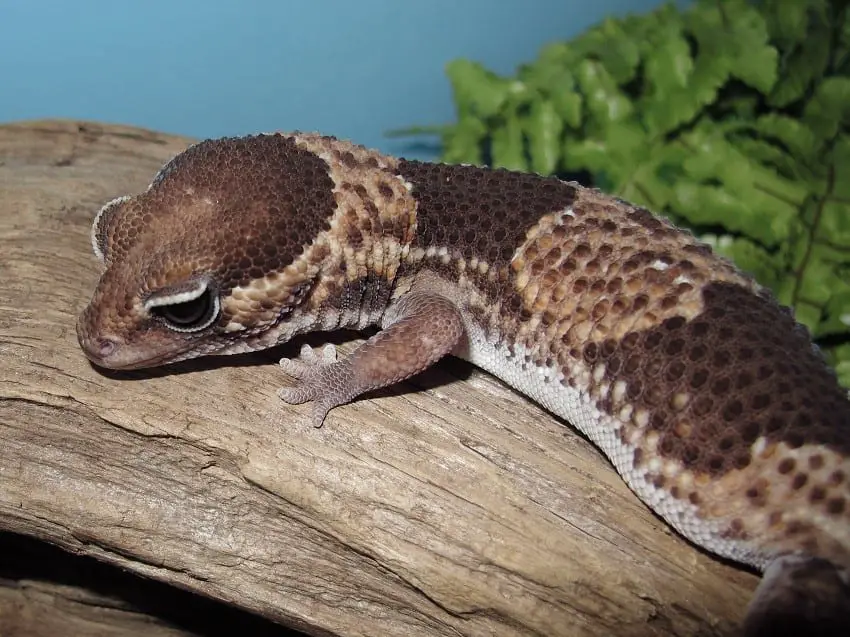
To better understand your pet African Fat-Tailed Gecko, get to know its many unique behaviors
- Shedding
Geckos shed regularly. This is the skin’s way of adjusting itself because of a lizard’s growing body. Naturally, smaller, juvenile African Fat-Tailed Geckos will shed more frequently than an adult or mature ones. And when your gecko is shedding, increase humidity inside the tank with a bowl of water. Avoid handling your pet and just monitor for signs of incomplete shedding.
- Docile behavior
One of the reasons why the African Fat-Tailed Gecko is a popular pet is because of its docile nature. Many first-time gecko or lizard owners prefer this species to a leopard gecko because of its even temperament and good nature. It won’t bite and won’t wiggle out of your hand, as well.
- Will mate with more females
This species of a gecko will mate with more females, while females will mate with more males possibly because of an innate need to multiply. This is why successful breeders place a single male with two, three, or more females inside a breeding tank.
- Are not good parents
Geckos are not really good parents. A female will lay eggs in the ground or inside an egg box in captivity and won’t come back to check on its eggs. It won’t care for its young after these have hatched from their shells too.
- Do not climb walls
African Fat-Tailed Geckos don’t have sticky feet or adhesive lamellae, unlike other gecko species. This is why you can keep this gecko on a tank with lower walls rather than a tall tank with tight covers.
- Will grow its tailback
One of the adaptations of the African Fat-Tailed Gecko is its ability to shed off its tail when it feels attacked, stressed, or threatened. The lost tail will be replaced with a rounded tail that looks like its head. This is another method of adaptation by this clever gecko to fool its predators.
- Nocturnal animal
This is a gecko that will sleep and rest in the day but will be active, eating, playing, and mating in the evening.
Shedding
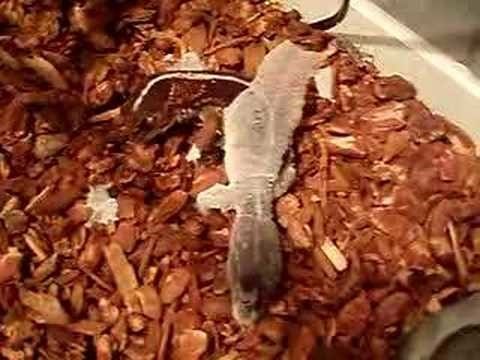
Shedding is usually complete (whole body in one go) for healthy lizards and in lizards grown in the ideal environment. But some geckos may have incomplete shedding wherein parts of the tail, hands, feet, and eyes have a difficult time to shed. The old skin falls off in flakes indicating metabolic problems.
To counter incomplete shedding and to help geckos shed completely, improve humidity levels inside the tank. If you can handle your pet well, soak it in warm water for at least a few minutes to loosen dead skin. After this, dead skin will be easily removed.
Shedding happens regularly in juveniles and can happen less frequently in adults and in senior geckos. Shedding is also stressful to most geckos, so it’s always best to leave your pet alone and just intervene when there are problems with shedding.
Habitat
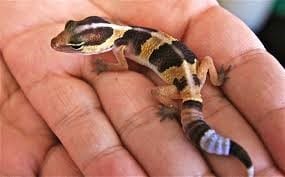
The right tank size is a 10-gallon tank, but a larger 20-gallon one is also a good idea. One or two geckos can stay in one tank, but during breeding time, remember to place one male is to two or more females for better breeding success.
When choosing a tank, be sure that there is still room for the gecko’s dishes, food, and water dishes. There must be rocks, branches, and areas where the gecko can sit and bask. Although this gecko can’t climb walls, you must still cover the top with a screen cover to prevent other pets or predators from entering the tank.
Place a lock on the cover to secure your pet. The tank must be placed in a quiet environment, preferably a spare room, basement, or attic so that this gecko can sleep and recuperate during the day. This is a nocturnal animal and will be active during the night time.
Lighting, Humidity, and Temperature
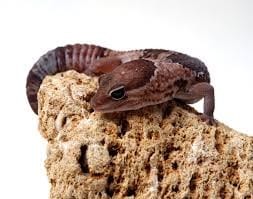
You must have an efficient and effective lighting system for your gecko. Incandescent light is the best, according to pet owners. It is also recommended that you expose your geckos to a minimum of 12 hours of light to mimic daylight.
Good incandescent lighting is also a good source of heat. Your tank must also sit on top of an under-cage heating pad. This type of heating will keep the tank interiors at 75 to 90 degrees Fahrenheit in the morning and between 85 to 90 degrees Fahrenheit in the nighttime.
Use a mister with water and apply a spray of water inside the tank to maintain tank humidity. Use a humidifier if you want more accurate humidity levels. Also, a bowl of water is a good way to maintain tank humidity. Keep this water clean always.
Tank Bedding and Accessories
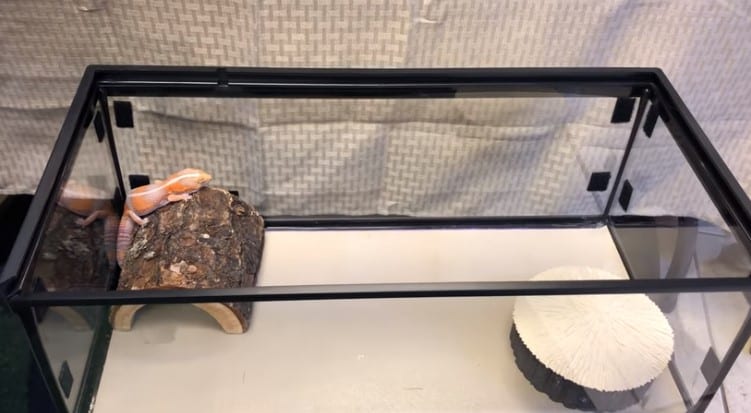
African Fat-Tailed Geckos are nocturnal, so provide areas where it can sleep peacefully in the morning. You can be as elaborate or as simple as you can, but remember your pet’s safety most of all. The accessories you place inside should be safe, must have no jagged or pointed edges that can hurt your pets.
You may also DIY accessories like a turned over clay pot, a shoebox with holes, or a plastic container. Place the lizard’s shelter near the heat source as much as possible.
For the bedding or substrate, use paper substrate for easy cleaning. Use newspaper, butcher, or packing paper or paper towel. Do not use sand because the gecko can ingest this, and this can impact its stomach or intestine. Do not use substrate materials with too much smell, which can instantly affect the health of geckos.
Sanitation
Clean your gecko’s cage with safe and effective cleaners. Sometimes basic cleaners work well than expensive cleaners. You can use bleach, dishwashing soap, and water. Make sure to rinse everything before you place the gecko inside. You may also use baking soda to clean the tank and remove foul odors.
If you want to use chemical cleaners, follow the instructions on the cover carefully. Never use two products at a time and always rinse well with running water. Dry the tank using paper towels before placing all the accessories and your pet in. You may also remove disease-causing bacteria with boiling water.
Availability – Where to Get One?
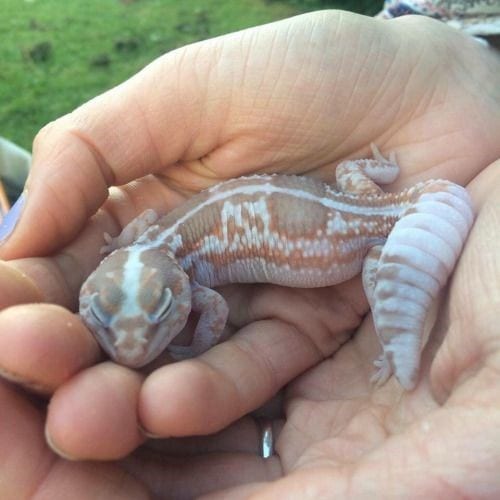
You can get an African Fat-Tailed Gecko from a local pet store or reptile trade shop, but it can take time before you take one home. This lizard is usually ordered from a trader or supplier online. The price for a regular African Fat-Tailed Gecko is around $1300, while those with more interesting designs and elaborate colors may cost more around $1500 to $2000.
Male geckos are often more expensive than females. Ready to breed geckos are more expensive than juvenile geckos.
How to Care for an African Fat-Tailed Gecko
Your African Fat-Tailed Gecko is in good hands when you remember the following techniques:
- Maintain good humidity levels inside the tank. This will prevent many illnesses, enhance shedding, and keep your lizard healthy and happy.
- Place the tank in a quiet area and maintain peace during the mornings since this gecko is a nocturnal animal.
- Handle your gecko as much as you can so it can develop trust and good handling nature.
- Handle your lizard well to prevent stress. Any stress can affect your gecko’s health and to keep it happy and healthy inside the tank.
- Avoid overcrowding. Allow only two lizards in a tank. Use smaller tanks for breeding and for laying eggs.
- Change your substrate frequently to prevent mold, bacteria, and parasites. Change the water inside the bowl, but don’t remove this inside the tank since this helps maintain humidity.
- Feed your gecko the best kind of food and take this as a good way to feed your geckos supplements and nutrients.
- Take your pet to the vet for any problems. Don’t manage
FAQs
What are the differences between a leopard gecko and an African Fat-Tailed Gecko?
Leopard Geckos are larger and longer. Also, leopard geckos have more special mutations in the eye with unique patterns on the body. African Fat-Tailed Geckos are smaller and have fat tails.
How long do African Fat-Tailed Geckos live?
African Fat-Tailed Geckos can live up to 20 years, but the average is only 15 years in captivity. There is no record as to how long this gecko can live in the wild.
Can you hold African Fat-Tailed Geckos?
Yes, you can hold this species of gecko even without proper training because it is one of the most docile lizards. And because of its docile nature, it makes a good first-time lizard pet for novice owners.
Do geckos like being handled?
Geckos are known to be easy to handle and may even like human contact for as long as it is held gently. Geckos like the African Fat-Tailed Gecko feel more comfortable with their owners as long as it is handled early.
Do geckos love to be petted?
As long as you regularly handle your pet gecko, it will be comfortable in your hands and will let you pet it. And as long as you hold the gecko in your hands, anyone can put it. The best part of the body to a pet is the lizard’s body but not too much on the head.
Do African Fat-Tailed Geckos recognize their owners?
Some gecko owners say that their pets are able to recognize them. They also say that geckos like the African Fat-Tailed Gecko are smart to recognize where its tank is and when feeding time is.
Do geckos become lonely?
The African Fat-Tailed Gecko, as well as other reptiles, are solitary animals, and therefore, there won’t feel lonely.
Is it true that African Fat-Tailed Geckos hear you?
African Fat-Tailed Geckos do not have outer ears like humans and other mammals only visible ear openings to catch audio from the environment. Their eardrums are found below the surface of the skin. They may not hear as good as humans, but they can hear only small sounds.

